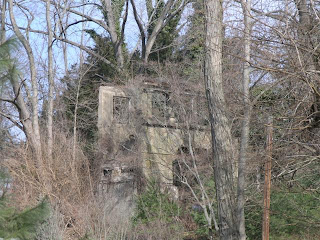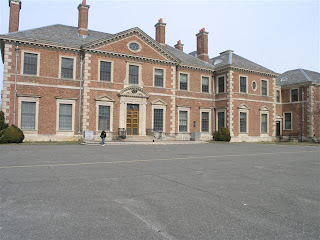This is the fourteen-foot, five-ton bronze statue of Whisper the legendary bull, a story of which I will impart later. He stands at a well known intersection and is a familiar sight around the Smithtown area. You can't miss him.
In 1903, Lawrence Smith Butler pitched the idea of the bull statue to Charles Cary Rumsey, his friend and sculptor known for his work with wildlife. Butler was a descendant Richard Smith, the founder of the village of Smithtown.
In 1923, the casting for the statue was completed in Brooklyn, but the bull never moved to Smithtown for lack of funds. Eventually it became a part of an exhibit in the Brooklyn Museum and was later moved into storage, In 1941, Mr. Butler was able to raise the funds required to bring the statue to the village and convinced the Town Board to build a pedestal for it. He also convinced the sculptor's heirs to donate it to the town.
On May 10, 1941, Whisper was presented to Smithtown by Mary Rumsey, the daughter of sculptor, Charles Cary Rumsey.
By the way, Richard Smith's bull originally didn't have a name. Whisper was named by elementary school students when the local paper ran a contest.
I did promise you the legend of Whisper the bull and here it is straight from an article I found on the web:
"As the story goes, the Indians made a pact with Smith, an English settler who knew a good real-estate deal when he saw one: He could keep whatever land he circled in a day's time riding atop his trusty bull named ``Whisper.''
A clever man, Smith waited for the longest day of the year, circa 1665, to undertake the trek. He even trotted out one of Whisper's favorite cows the night before to trace the route. Her fetching scent would surely quicken Whisper's pace and get Smith to the end of the 55-mile border in time. He would start at the east end of what is now Smithtown, go south to Raconcamuck, now known as Ronkonkoma, then west to Hauppauge and north along what is today Veterans Highway and on to Town Line Road, which marks the town's western border, and finally north to the edge of Long Island Sound.
At noon, he -- and the bull -- rested. Smith munched on bread and cheese in a hollow, inspiring the name Bread and Cheese Hollow Road. Naturally, Smith got 'round, and Smithtown was his."

The article goes on to explain how Smith (spelled Smythe originally) really founded the town:
"That's the legend. Now here's what historians say really happened. Before Smith ever thought of founding a town in his name, he came to Southampton.
Actually, Smith first got off the boat, the John of London, from England at the Massachusetts Bay Colony in 1635. Because land there was already scarce and the Puritans extremely severe, he soon made his way to Long Island.
The first mention of Smith, then spelled Smythe, in the Southampton town records was in 1643. Soon after his arrival, Smith befriended Lion Gardiner, the first lord of the manor of Gardiners Island, and quickly rose into the fledgling settlement's highest social circles."
 |
Smith riding his bull Whisper to set the borders for Smithtown. From a 1939 mural.
|
|
Here's the rest of the story:
"Along the way, Smith must have tweaked a nose or two. In 1656, he was banished from Southampton for insulting the wrong people. The order is reprinted in Noel Gish's book, ``Smithtown, New York: 1660-1929.'' It reads:
It is ordered by the general court that Richard Smythe for his Irreverent carriage towards the magistrates contrary to the order was adjudged to be banished out of the towne and he is to have a weeks liberty to prepare himself to depart, and if at any time he be found after this limited week within the towne or the bounds thereof he shall forfeit twenty shillings.
Smithtown didn't come into play yet. Smith's next stop was Setauket, where in 1657 he set up house with his wife, Sarah, and their nine children.
Other forces were at work. The great Indian sachem Wyandanch gave Lion Gardiner a gift of land for rescuing his daughter, the Heather Flower, from a hostile tribe. Gardiner signed over the land that would become Smithtown to Smith in 1663. Smith either bought it or won it in a card game, depending on who's telling the story.
But the true tale doesn't end there. It took Smith a dozen more years of court battles to ensure that Smithtown was really his. When the English court didn't give him what he wanted, he tried the Dutch. And when the Dutch lost New York, he went back to the English. It went on and on. Finally, the last bits of Smithtown were declared his in the Andros Patent of 1677. Sounds like Smith was more of a bull than Whisper was.
``If you think about the fact that he got to two colonial governors with his boundary dispute, I think he was a very educated and determined man. He was absolutely determined to secure this land,'' said Hall. ``I wouldn't call him pushy, that's too modern a word.''
Though it's likely Smith's demeanor may have had something to do with inspiring the ``Bull'' myth, historians have come up with several theories. One is that Smith had a pet bull he liked to walk around town. Others point to Smith's coat of arms: A bull rising out of a shield decorated with six fleur-de-lis symbols.
Then there's Gish's theory, an interesting take on papal bulls. Apparently, papal bulls, decrees issued to settle matters of church and state, were very popular during the 17th Century. Papal bulls were sometimes used to resolve boundary disputes between dioceses or parishes. Gish argues that Smith could have issued his own ``Smith Bull'' to solve, once and for all, his boundary disputes with the Dutch, the English and the neighboring town of Huntington.
Of course, many people, especially Smithtown residents, dismiss these theories in favor of the fanciful fiction. It may be full of bull, but it's Smithtown's bull.
``When I first heard it, I thought it was somewhat farfetched, but it was a lovely story,'' said Smithtown Supervisor Pat Vecchio. ``As the years go by, it seems less far-fetched to me. You hear it so often, you begin to believe it.''
Asked almost weekly about the legend, Hall has developed her own strategy for handling the ultimate question of authenticity. ``I show them the map done for the town's bicentennial. We talk about whether there were Indian trails along the route and how the bull could have covered that much territory if it was covered in underbrush. Then I let them decide.''"
Courtesy http://newsday.com/community/guide/lihistory
I hope you have enjoyed the legend of Whisper and found out some interesting things about it. I know I did. Here are the links:
Here's the article that I borrowed the story from and the pic of the mural:
Smithtown's official website
Article in Smithtown Patch about the history of Whisper:
Wikipedia article:
old photos of Smithtown :























